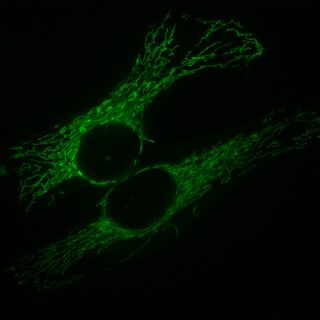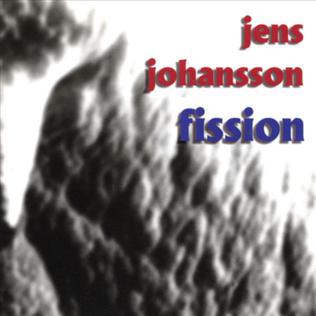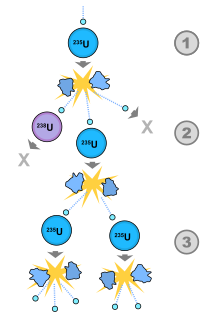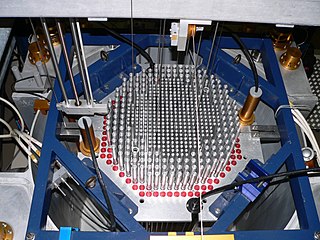| Look up fission in Wiktionary, the free dictionary. |
Fission, a splitting of something into two or more parts, may refer to:
| Look up fission in Wiktionary, the free dictionary. |
Fission, a splitting of something into two or more parts, may refer to:
Fission, in biology, is the division of a single entity into two or more parts and the regeneration of those parts to separate entities resembling the original. The object experiencing fission is usually a cell, but the term may also refer to how organisms, bodies, populations, or species split into discrete parts. The fission may be binary fission, in which a single entity produces two parts, or multiple fission, in which a single entity produces multiple parts.

Although mitochondria are commonly depicted as singular oval-shaped structures, it has been known for at least a century that they form a highly dynamic network within most cells where they constantly undergo fission and fusion. Mitochondria can divide by prokaryotic binary fission and since they require mitochondrial DNA for their function, fission is coordinated with DNA replication. Some of the proteins that are involved in mitochondrial fission have been identified and some of them are associated with mitochondrial diseases. Mitochondrial fission has significant implications in stress response and apoptosis.

In nuclear physics and nuclear chemistry, nuclear fission is a nuclear reaction or a radioactive decay process in which the nucleus of an atom splits into smaller, lighter nuclei. The fission process often produces free neutrons and gamma photons, and releases a very large amount of energy even by the energetic standards of radioactive decay.
Cold fission or cold nuclear fission is defined as involving fission events for which fission fragments have such low excitation energy that no neutrons or gammas are emitted.
Fast fission is fission that occurs when a heavy atom absorbs a high-energy neutron, called a fast neutron, and splits. Most fissionable materials need thermal neutrons, which move more slowly.
Singlet fission is a spin-allowed process, unique to molecular photophysics, whereby one singlet excited state is converted into two triplet states. The phenomenon has been observed in molecular crystals, aggregates, disordered thin films, and covalently-linked dimers, where the chromophores are oriented such that the electronic coupling between singlet and the double triplet states is large. Being spin allowed, the process can occur very rapidly and out-compete radiative decay thereby producing two triplets with very high efficiency. The process is distinct from intersystem crossing, in that singlet fission does not involve a spin flip, but is mediated by two triplets coupled into an overall singlet. It has been proposed that singlet fission in organic photovoltaic devices could improve the photoconversion efficiencies.
Fission is a Swedish melodic death metal band formed in 2002. The band began as Benny Hägglund's personal project, with the hopes of fusing melody and aggression into his music. After writing some material, he decided to seek aid from Andreas Hedlund of Vintersorg, the band in which Hägglund plays live session drums. After recording a two-track demo with Benny handling all instrumentation and Andreas handling vocal duties, they signed on with Austrian label, Napalm Records. Benny continued writing all of the songs for their first full-length, while Andreas provided all of the lyrics, vocals, keyboards, and sound effects. They released their first full-length album, Crater, on April 27, 2004.

Fission is a studio album by keyboardist Jens Johansson, released in 1997 through Heptagon Records (Europe); February 18, 1998 through Pony Canyon (Japan); and on March 24, 1998 through Shrapnel Records. According to Johansson, the album went through an extremely troubled recording process due to several mishaps with Andy West's bass parts, which ultimately never made the album. On his website, Johansson also revealed that the indistinct image on the cover art is actually a heavily zoomed-in section of ice on a car window.
| This disambiguation page lists articles associated with the title Fission. If an internal link led you here, you may wish to change the link to point directly to the intended article. |

Asexual reproduction is a type of reproduction by which offspring arise from a single organism, and inherit the genes of that parent only; it does not involve the fusion of gametes, and almost never changes the number of chromosomes. Asexual reproduction is the primary form of reproduction for single-celled organisms such as archaea and bacteria. Many plants and fungi sometimes reproduce asexually. Some Asexual cells die when they are very young.

The cell is the basic structural, functional, and biological unit of all known living organisms. A cell is the smallest unit of life. Cells are often called the "building blocks of life". The study of cells is called cell biology or cellular biology.
Fusion, or synthesis, is the process of combining two or more distinct entities into a new whole.

A nuclear chain reaction occurs when one single nuclear reaction causes an average of one or more subsequent nuclear reactions, this leading to the possibility of a self-propagating series of these reactions. The specific nuclear reaction may be the fission of heavy isotopes. The nuclear chain reaction releases several million times more energy per reaction than any chemical reaction.

A nuclear reactor, formerly known as an atomic pile, is a device used to initiate and control a self-sustained nuclear chain reaction. Nuclear reactors are used at nuclear power plants for electricity generation and in propulsion of ships. Heat from nuclear fission is passed to a working fluid, which in turn runs through steam turbines. These either drive a ship's propellers or turn electrical generators' shafts. Nuclear generated steam in principle can be used for industrial process heat or for district heating. Some reactors are used to produce isotopes for medical and industrial use, or for production of weapons-grade plutonium. Some are run only for research. As of early 2019, the IAEA reports there are 454 nuclear power reactors and 226 nuclear research reactors in operation around the world.

Cell division is the process by which a parent cell divides into two or more daughter cells. Cell division usually occurs as part of a larger cell cycle. In eukaryotes, there are two distinct types of cell division: a vegetative division, whereby each daughter cell is genetically identical to the parent cell (mitosis), and a reproductive cell division, whereby the number of chromosomes in the daughter cells is reduced by half to produce haploid gametes (meiosis). Meiosis results in four haploid daughter cells by undergoing one round of DNA replication followed by two divisions. Homologous chromosomes are separated in the first division, and sister chromatids are separated in the second division. Both of these cell division cycles are used in the process of sexual reproduction at some point in their life cycle. Both are believed to be present in the last eukaryotic common ancestor.

Reductionism is any of several related philosophical ideas regarding the associations between phenomena which can be described in terms of other simpler or more fundamental phenomena.
Division or divider may refer to:

Nuclear weapon designs are physical, chemical, and engineering arrangements that cause the physics package of a nuclear weapon to detonate. There are three existing basic design types:

Schizosaccharomyces pombe, also called "fission yeast", is a species of yeast used in traditional brewing and as a model organism in molecular and cell biology. It is a unicellular eukaryote, whose cells are rod-shaped. Cells typically measure 3 to 4 micrometres in diameter and 7 to 14 micrometres in length. Its genome, which is approximately 14.1 million base pairs, is estimated to contain 4,970 protein-coding genes and at least 450 non-coding RNAs.
The term cell growth is used in the contexts of biological cell development and cell division (reproduction). When used in the context of cell development, the term refers to increase in cytoplasmic and organelle volume, as well as increase in genetic material following the replication during S phase. This is not to be confused with growth in the context of cell division, referred to as proliferation, where a cell, known as the "mother cell", grows and divides to produce two "daughter cells".

Nuclear fission products are the atomic fragments left after a large atomic nucleus undergoes nuclear fission. Typically, a large nucleus like that of uranium fissions by splitting into two smaller nuclei, along with a few neutrons, the release of heat energy, and gamma rays. The two smaller nuclei are the fission products..
Fragmentation in multicellular organisms is a form of asexual reproduction in which an organism is split into fragments. Each of these fragments develop into matured, fully grown individuals that are identical to their parents.
In the science of biology, a mechanism is a system of causally interacting parts and processes that produce one or more effects. Scientists explain phenomena by describing mechanisms that could produce the phenomena. For example, natural selection is a mechanism of biological evolution; other mechanisms of evolution include genetic drift, mutation, and gene flow. In ecology, mechanisms such as predation and host-parasite interactions produce change in ecological systems. In practice, no description of a mechanism is ever complete because not all details of the parts and processes of a mechanism are fully known. For example, natural selection is a mechanism of evolution that includes countless, inter-individual interactions with other individuals, components, and processes of the environment in which natural selection operates.
Bond cleavage, or scission, is the splitting of chemical bonds. This can be generally referred to as dissociation when a molecule is cleaved into two or more fragments.
Mitochondrial biogenesis is the process by which cells increase mitochondrial mass. It was first described by John Holloszy in the 1960s, when it was discovered that physical endurance training induced higher mitochondrial content levels, leading to greater glucose uptake by muscles. Mitochondrial biogenesis is activated by numerous different signals during times of cellular stress or in response to environmental stimuli, such as aerobic exercise.

Ternary fission is a comparatively rare type of nuclear fission in which three charged products are produced rather than two. As in other nuclear fission processes, other uncharged particles such as multiple neutrons and gamma rays are produced in ternary fission.
Asexual reproduction in starfish takes place by fission or through autotomy of arms. In fission, the central disc breaks into two pieces and each portion then regenerates the missing parts. In autotomy, an arm is shed with part of the central disc attached, which continues to live independently as a "comet", eventually growing a new set of arms. Although almost all sea stars can regenerate their limbs, only a select few sea star species are able to reproduce in these ways.